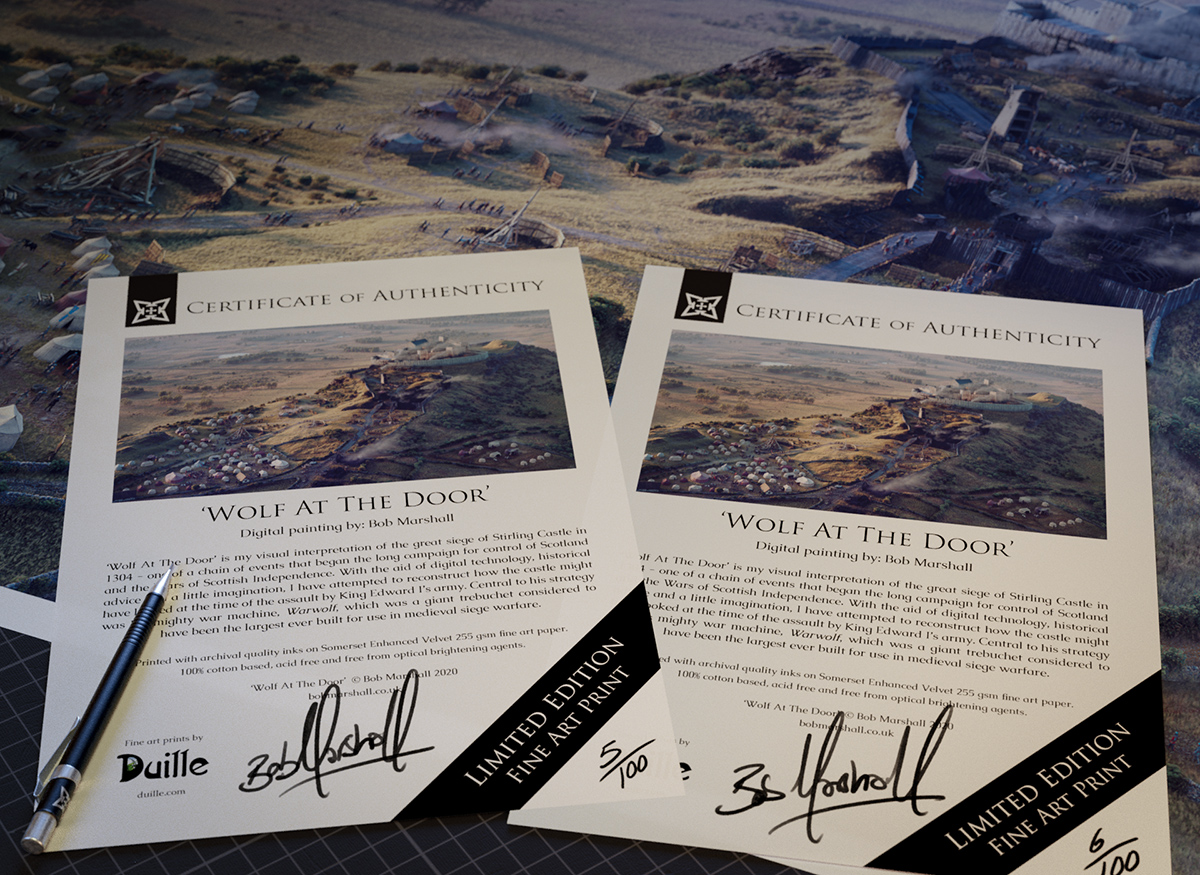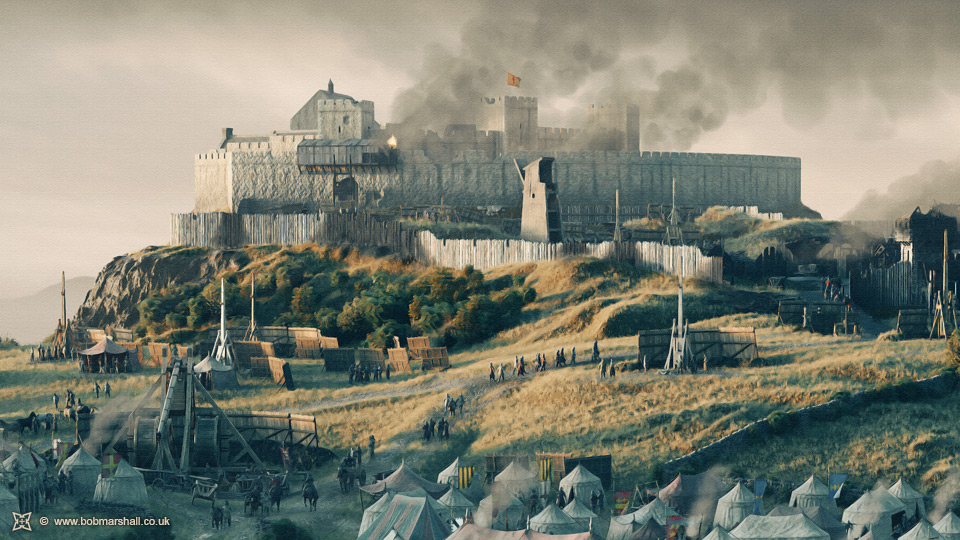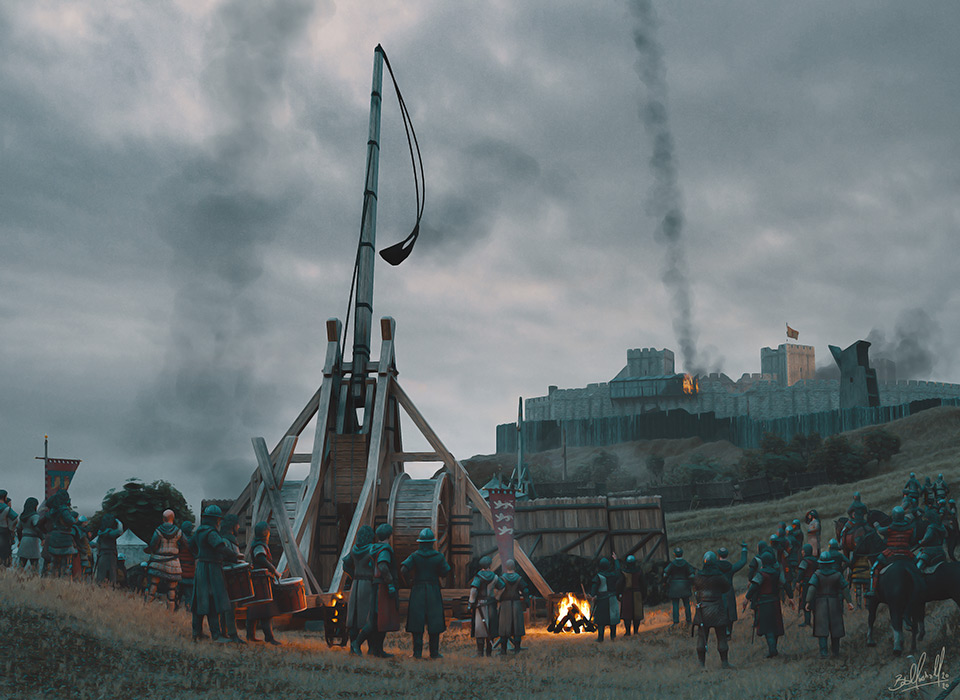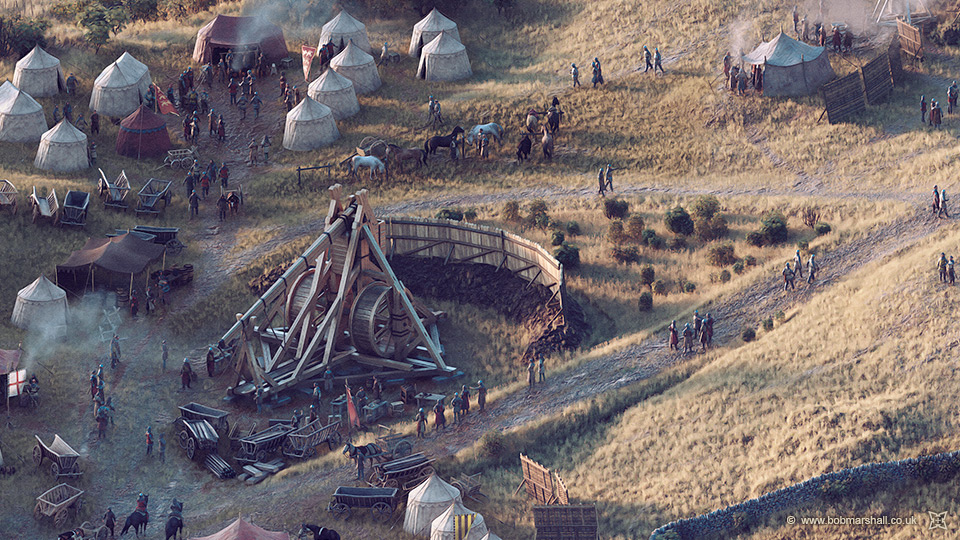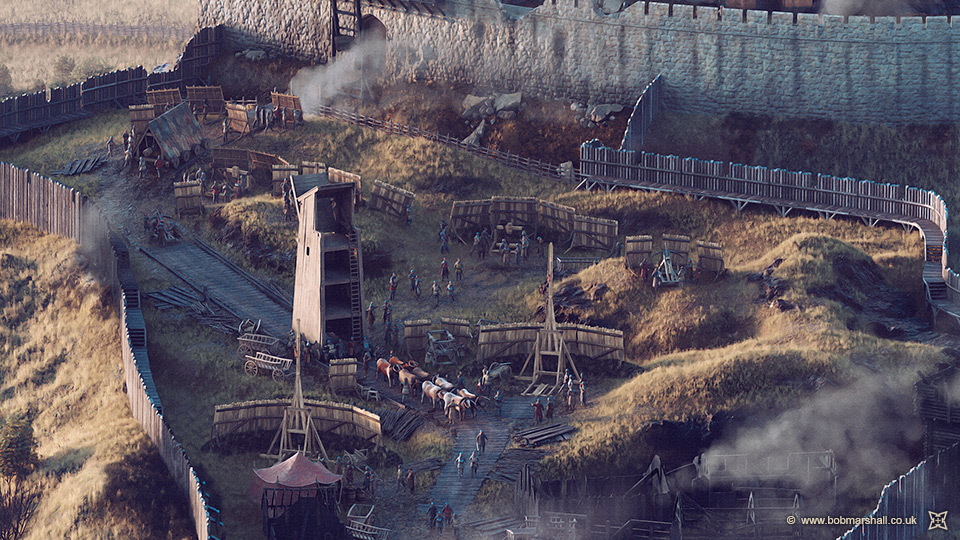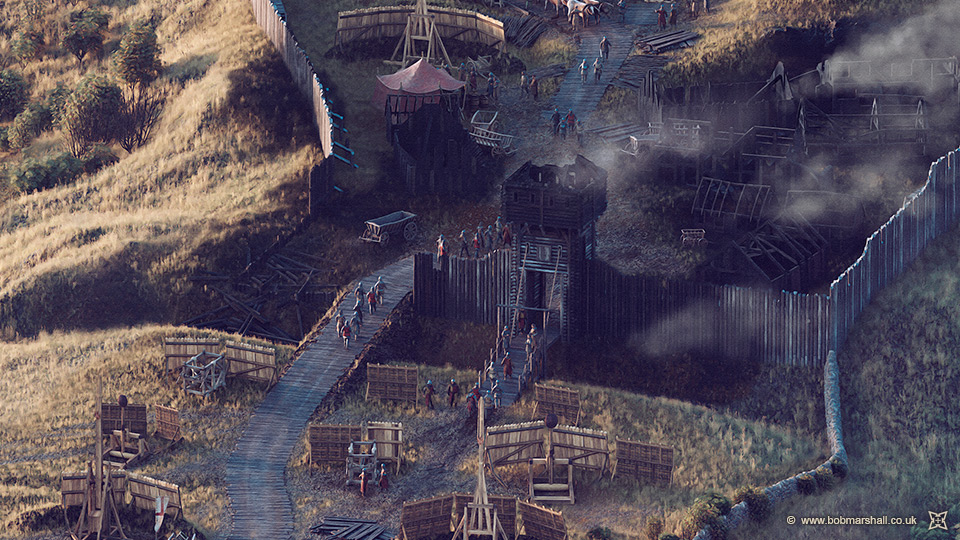
(HD version from a 14K, 100 mega-pixel image).
'Wolf At The Door' is my visual interpretation of the great siege of Stirling Castle in 1304 - one of a chain of events that began the long campaign for control of Scotland and the start of the Wars of Scottish Independence. My aerial view of the siege is the largest single image digital reconstruction I have so far produced, and possibly one of my most detailed. The project was partly inspired by the opening scenes in the Netflix film 'Outlaw King' which was released at the end of 2018.
With the aid of digital technology, historical advice and a little imagination, I have attempted to reconstruct how the castle might have looked at the time of the assault by King Edward I's army and his mighty war machine, the giant boulder-throwing trebuchet or catapult Loup de Guerre (Fr.), or Warwolf to apply its more familiar anglicised name. A seriously impressive marvel of medieval engineering, Warwolf was thought to have been capable of hurling an object with the equivalent mass of two adult men a distance of over 200 yards. It was state of the art weaponry for its time and considered to have been the largest trebuchet ever built.
The aerial view of the siege is a large, one-hundred million-pixel image produced from a 3D model with some post-render painting work achieved using image editing software. Two smaller images from a viewpoint at ground level were produced in this same way. The project took over five-hundred hours to accomplish, working on it in spare time between other projects over the course of sixteen months. It is an uncommissioned personal project created with the generous help and guidance of castle historian and author, Simon Forder with additional input from several historians and archaeologists. Although I have received some high-level academic feedback, no one can be absolutely certain what Stirling castle looked like at this period in time and therefore much of this visual reconstruction is speculative.
Large scale military sieges of castles were often prolonged and costly affairs lasting for many months. The activity which I have detailed in this reconstruction attempts to condense into a single image what would more likely have been a series of intense and dramatic actions spread out over the course of the wider campaign rather than an interpretation of everything taking place at the same moment. I have blended some elements from the film's theatrical interpretation with a few of my own and combined this with a considered reconstruction of the landscape and speculative appearance of the early castle with some of Simon's help.
The 3D model was painstakingly built in layers using data obtained from Ordnance Survey maps. Over a period of several weeks in October and November 2018, I worked with Simon to try to reconstruct the form of the early castle using sketch drawings and by building models while referring to the very limited archaeological information that exists of the pre-sixteenth century castle. After victory at the battle of Bannockburn, Robert the Bruce ordered the castle to be dismantled. Understanding what Stirling Castle looked like prior to the later palace built for the Royal Stewarts requires some imagination.
There are few depicitions of the early castle except for one vivid image which appears in Walter Bower's 1440s manuscript, Scotichronicon. Although this document is dated over a hundred years after Bannockburn, the image depicts what appears to be a substantial castle with interval towers enclosed within an outer defensive curtain wall of curvilinear form. While it is difficult to know how much to trust this image (medieval artists are known for exaggeration), if one considers the geography of the landscape and the general logic to castle development and construction from the time, then it is not totally implausible. Simon and I have attempted to communicate the castle's earliest roots which possibly developed as a timber-enclosure castle from the reigns of Alexander I (early c12th) to Alexander III (mid c13th), and this castle likely evolved from the profile of a much earlier hill fort.
The Siege
In the spring of 1304 and up until its capture and surrender, Stirling Castle was held by a Scots garrison of some 40 men led by its governor, Sir William Oliphant, who refused to surrender it to Edward I without the permission of John de Soules, then Guardian of Scotland who was exiled to France at that time. Weakened by weeks of continuous bombardment by Edward's arsenal of over a dozen smaller catapults or siege engines, the Scots garrison promptly surrendered to Edward upon sight of the awesome Warwolf being assembled outside the castle's outer walls. But the English King wasn't content to call off the assault without having first fully demonstrated the capability of his new war machine. Famously ordering Oliphant and his men to return to within the confines of the castle walls, the mighty trebuchet began to hurl massive boulders and volleys of Greek fire at the fortress. Only after the castle sustained extensive damage - an entire wall was destroyed; the garrison were permitted to surrender.
Warwolf
There are few if any descriptions of Warwolf to tell us what this looked like although it is said to have taken five master carpenters and 50 skilled workers over two months to assemble it within range of the castle. The materials to construct it were transported by horse and cart from great distances. Edward I even ordered the lead sheets to be stripped from the roofs of all the churches as far away as St Andrews, transported to Stirling and then melted down to fill its counterweight.
In 1998, an experiment was carried out by researchers to reconstruct and test two working siege engine replicas at Urquhart Castle in Scotland (Nova Secrets Of Lost Empires Medieval Siege). They calculated that in order to deliver a 250lb payload to its target a distance of 200 yards away, it would have required a counterweight mass of between five and six tons. Two potential designs were constructed and tested. After a series of unsuccessful attempts, both replica siege engines eventually succeeded in striking their targets, although leaving us with the conclusion that the form of Warwolf could have easily been either one of these two designs. Since this does little to help us clarify its true appearance, I have had to resort to some imagination here.
For my reconstruction, I have drawn influences from the working replica medieval trebuchet at Warwick castle which was designed by Dr Peter Vemming from The Medieval Centre in Nykobing, Denmark. Interestingly, it is the Warwick castle trebuchet that seems to have influenced the design of Warwolf in the Netflix film Outlaw King (2018). The film also depicts the events of the siege of Stirling Castle in 1304 in its opening scenes. I had developed my 3D model of Warwolf a few months before I saw the film and I was rather interested to observe that its producers had a adopted the same design, presumably under some diligent historical advice!
Among the other siege engines that are recorded as having been present at the siege include 'le berefry' - very likely the same timber siege tower or belfry that took part in Edward I's siege of Bothwell Castle in 1301. M.A. Haskell writes in his thesis The Scottish campaign of Edward I, that the garrison were more fearful of this siege tower than they were of Warwolf. One of these siege engines may have been a sow or cat. As close as one could get to a tank in medieval times, this is probably best described as an armoured shed on wheels. It housed a massive timber battering ram which could be swung at the walls or gates to breach them.
The background scenery
My reconstructed view looks North West towards the King’s Park and the land beyond was mostly uncultivated, low-lying marshland at the time of the siege in 1304. During Alexander III’s reign (1249-1286), a large hunting park existed just to the west of the castle. Richard Oram explained to us that a series of excavations at Kincardine, Buzzart Dykes and Durward’s Dyke demonstrated the scale of these park boundaries - a massive 2m deep ditch and a 2m high turf and earth dyke on the inner face topped with a pale fence to create a boundary that retained deer within the park. According to archaeologist Murray Cook, no evidence has yet been found for such a boundary at King’s Park, Stirling, but he helped me to plot its speculative route and this is the long, straight feature that appears in top left-hand side of my aerial reconstruction image. The ditch would be on the opposite side of the pale fence which is obscured from our view.
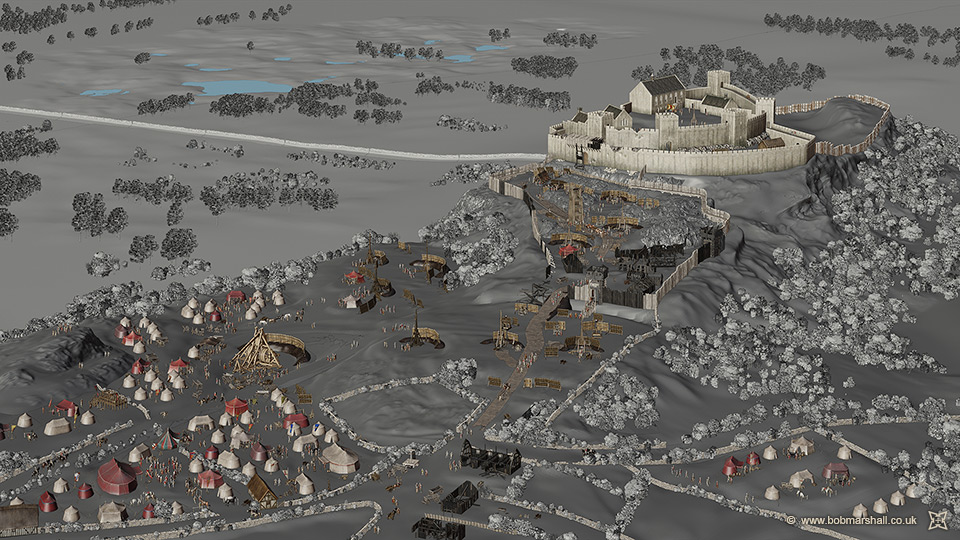
Production Notes
The computer 3D model that I built for this project was created for the purpose of producing detailed 2D images which is part of my usual workflow. I chose this project intentionally in order to try out some of the improvements that were made in the 2.80 release of the Blender 3D software that emerged at the end of 2018. Blender happens to be the program that I am most familiar with - having used it for over fifteen years. However, it is not the most ideal or efficient 3D software for handling very large data-sets like this. Although I use techniques such as object instancing to reduce the load on computer memory, having several thousand assets populating this busy scene severely affected Blender's performance. Perfoming what are normally quite routine actions such as undo or duplicating selections became frustratingly slow processes. Despite such high demands I placed on Blender, I am absolutely amazed at what this freely-available software let me get away with.
Bringing my reconstructions to life with animation and creating virtual experiences is something I aspire to. I would have loved to have fully animated some elements of this project but it would have required considerably more time, financial support and resources than I had allowances for. Had animation been my goal from the beginning, I would have approached this project in a completely different way, most likely by way of a game engine. Advances in real-time rendering for gaming technology have opened up exciting new possibilities in this area and this is something I am considering carefully for the future. Such ambitious projects are probably best tackled collaboratively, although there are challenges to achieving that with what are usually extremely restrictive time constraints and budgets.
The 3D Model
Watch the fly-through animation of the digital 3D model I built to create 'Wolf At The Door'. Best viewed in fullscreen!
Acknowledgements
I am most grateful to the following individuals for their generous assistance and for the valued feedback they have all given me at various stages of this project:
- Dr. David Caldwell - Keeper of Scotland & Europe in the National Museums of Scotland (Retired)
- Dr. Murray Cook - Archaeology Officer, Stirling Council
- Simon Forder - Historical Consultant and Author (www.thecastleguy.co.uk)
- Prof. Richard Oram - Professor of Environmental and Medieval History, University of Stirling
- Dr. Dan Spencer - Historian and author (www.danspencer.info)
- Peter Yeoman - Independent Archaeologist and Heritage Consultant
References and further reading
- The Siege of Stirling Castle in 1304 - Dan Spencer
- The Warwolf - James Macivor
- Stirling Castle, the reason for the Battle of Bannockburn - Simon Forder
- The Legend of Ludgar the War Wolf, King of the Trebuchets. Edward Longshanks' master machine of death - William Gurstelle
- The Scottish campaign of Edward I, 1303-4 - M.A. Haskell, Durham E-Theses
- The Hammer of the Scots: Edward I and the Scottish Wars of Independence - David Sanituste
"Wolf At The Door"
All images © copyright Bob Marshall 2020.
- Created in Blender 3D and Adobe Photoshop.
- Production time: Approx 3 months
- Format: Digital TIFF (.tiff) image
- Print-ready image size: 14,000 x 7,700 (100 million pixels) / 118.53 x 65.19 cm @ 300dpi.
Featured project on Blender Artists!
Use of Images
Contact me if you wish to use my artwork for use in printed books, magazines, posters, broadcast, etc. Please refer to my image licencing rates for further details.
You are welcome to use any of my artworks on this page in your personal projects and presentations or for educational use, and you may also share these on social media as long as you credit me. Please refer to the full terms in my Non-Commercial Image License Agreement.
Prints & Posters
SOLD OUT
